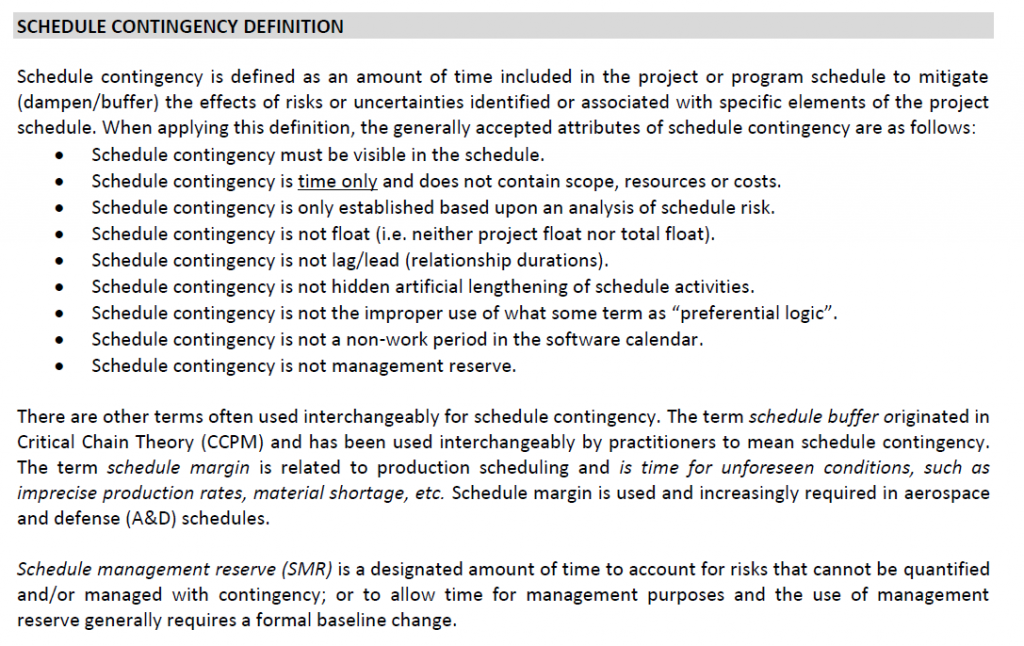פוסט זה נכתב על-ידי שלושה מומחי לוחות זמנים (לפי סדר א'-ב'):
אסף מורג – מנכ"ל רקיע;
טוני לופו – מייסד ובעלים toni@pbm.co.il, PBM;
טל לבנון – CTO ובעלים משותף ב- טל לבנון – HCP בע"מ;
מה קובע ה- AACE בארה"ב?
1. בארה"ב –
הארגון הגדול ביותר בעולם המערבי שקבע כללים ונורמות בנושא מרווח הבטחון הוא ה-AACE (American Association for Cost Estimate).
מאחר וה- AACE עוסק גם בנושאי זמן וגם בנושאי עלות, הוא מפריד בשימוש במונחים השונים לתחומים השונים. Management Reserve עוסק ברזרבות כספיות בלבד, בעוד ש – Management Schedule Reserve עוסק ברזרבות זמן בלבד. המונח Contingency שמור לנושא המרווח הכספי, בעוד ש- Schedule Contingency הוא נושא מרווח הזמן.
להלן הגדרת Schedule Contingency:
AACE® International Recommended Practice No. 70R-12, Principles of schedule contingency management as applied in engineering, procurement, and construction:

ה- AACE הגדיר את הבעלות על הבאפר (Float) באופן נחרץ ופשוט – הבאפר הוא של הקבלן.
AACE® International Recommended Practice No. 29R-03
Ownership of Float
Project float is the time between the last schedule activity on the baseline schedule and the contractual completion date where the contractual completion date is later than the scheduled completion date. In this case, in the absence of contrary contractual language, project float is owned solely by the contractor.
ב- 10S-90 ישנן הגדרות רבות למונחים רבים:
AACE® International Recommended Practice No. 10S-90, Rev. May 27, 2021:
SCHEDULE BUFFER – Syn.: SCHEDULE CONTINGENCY.
SCHEDULE CONTINGENCY – (1) Duration added to a schedule activity to allow for the probability of possible or unforeseen events. Use in this manner is not recommended as the contingency is hidden and may be misused. (2) A unique activity used to model specific float available to a project phase. Used in this manner gives ownership of float to those activities and or responsibility entity. (3) The amount of time added to specific activities of a project (or program) schedule to mitigate (dampen/buffer) the effects of risks or uncertainties identified or associated with specific elements of that schedule. Syn.: SCHEDULE BUFFER. See also: SCHEDULE MARGIN. (October 2013)
לסיים פרויקטים בזמן – זה רק חלום או שאפשר להגשים במציאות?
שיחה בת 30 דקות, ללא עלות, עם טל לבנון.
קליק, פרטים ונחזור אליך. מבטיחים.
ב- 10S-90 ישנן הגדרות רבות למונחים רבים:
ה- AACE מגדיר בנוסף לכך, כי אם מזמין העבודה מגדיר מרווח, אזי מרווח זה הוא רזרבה (עתודה) ניהולית שלו מחוץ לתכולת הפרויקט באופן הבא:
SCHEDULE MARGIN (SM) – Schedule margin or schedule reserve are interchangeable terms meaning duration added to a schedule activity to allow for the probability of possible or unforeseen events. It is typically based on a schedule risk assessment and is measured in the unit of the schedule (typically days). For earned value management, schedule margin is usually limited to logical end points within the schedule. Schedule margin acts as a buffer between the baseline activities and the project end date. It may be considered management reserve (MR) in time units. Syn.: SCHEDULE RESERVE. See also: MANAGEMENT RESERVE; SCHEDULE CONTINGENCY. (October 2013)
MANAGEMENT SCHEDULE RESERVE (MSR) – A designated amount of time to account for risks that cannot be quantified and/or managed with contingency, or to allow time for management discretionary purposes and the use of management reserve generally requires a formal baseline change. Management reserves are generally not related to schedule contingency. See also: MANAGEMENT RESERVE (MR). (October 2013)
במילים אחרות – אין לבלבל בין ההגדרות. אותו מרווח השייך למזמין איננו חלק מתכולת העבודה של חוזה הקבלן והמרווח של הקבלן אינו כולל את השינויים של המזמין או איחורי המזמין.




